George Romney Biography
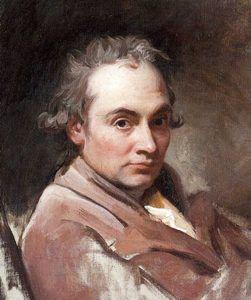
George Romney was born in 1734, in Dalton-in-Furness, Lancashire, to the family of an inventive and entrepreneurial carpenter, John Romney. George inherited much of his father’s creativity, and spent many of his younger years sketching and doodling in his school notebooks.
This came to the detriment of his grades, and his father took him away from school before the age of eleven so that he could focus on his more commendable traits. Romney set to work in his father’s workshop, where he quickly learned the tools of the trade. In his free time, however, he still preferred to practice painting, often copying pictures from various monthly magazines that were lent to him by his father’s employees. It wasn’t until he sketched a strikingly accurate portrait of one of the local villagers, at her request, that his father recognized George’s calling as an artist and, after some persuasion from both his friends and his son, apprenticed him to a traveling artist who was in the area.
While the artist, Steele, wasn’t a very good painter himself, he had received a good art education in Paris, and was able to teach Romney many of the basic and most crucial skills needed in the field. However, although the apprenticeship got off on a smooth start, Steele shortly thereafter eloped with one of his pupils, and Romney volunteered to help with the arrangements. The frequent nighttime efforts proved too much for the young apprentice and, shortly after Steele left the area, Romney fell ill with a fever, and was subsequently nursed back to health by a local nurse, Mary Abbot, whom he would marry after recovering from his illness in 1756. He had to leave her a short while later to continue his apprenticeship with Steele, now living in York. But Steele’s traveling lifestyle, negligent habits and near-chronic bankruptcy discouraged Romney, and he agreed to forgive Steele a debt of ten British pounds in exchange for terminating his apprenticeship.
He returned to his wife in Kendal, where he took up work as a painter. Beginning with drawing signboards, he soon made a reputation as a skilled portraitist, which attracted the wealthier clientele living in the area. In an attempt to turn his usual pastimes into profitable business, he also turned to landscapes and historical paintings, many of which he sold in lotteries at the local town hall. By and by this business earned the family a modest fortune, and the artist set his sights on London, hoping to find more and greater patrons in the capital. A Boating Party on Lake Windermere, (c.1757), Colonel George Wilson with his Dogs, (c.1758-59), Jane Atkinson, (c.1759).
Romney left home in 1762, leaving most of his savings to his wife and children, who moved in with Romney’s father a year later. George’s stay in London would last until 1799, during which he only twice returned to visit his family, though he continued to provide for them and ostensibly no hard feelings were developed due to this seeming abandonment.
The artist arrived in the big city with no references or connections, as a result of which the first ten years of his stay there brought him little fame as he struggled to provide for himself and his faraway family. His first attempt to get into the limelight took the form of entering a historical art competition hosted by the Society of Arts, to which he submitted The Death of General Wolfe (circa 1763). The painting was initially awarded second place, which entailed a premium of fifty guineas. However, the award was later retracted upon claims of fraud, and later still, after this was disproved, disqualified for the subject matter not being strictly historical and a recent event. The Society’s council still paid Romney an ex-gratia sum of twenty-five guineas, but this slight dealt to him by contemporary leading artists would leave him with a grudge he’d hold for years to come.
Not long after his move to London, Romney made an effort to visit mainland Europe, in particular Italy. The artist wanted to study works of the great painters, something that he considered a key missing facet in his arts education. Unfortunately, lack of funds weighed him down and he had to make do with a trip to Paris. Much of his tour was spent in galleries and churches, studying and copying paintings.
He returned to England after about two months and set to work with a passion, once again running in a competition at the Society of Arts and walking away with the grand prize of fifty guineas. At this time he befriended Richard Cumberland, a fairly well-known playwright, through whom he met some of his more prominent patrons.
The improved business alleviated his financial woes, and in 1773 he finally made his desired trip to Rome. This time he came prepared, accompanied by his friend and fellow artist Ozias Humphry, with numerous references and bearing letters of introduction for Pope Clement XIV and diplomat Sir William Hamilton. The former of these received the two amicably and arranged for scaffolding to be set up in the Vatican so that Romney could have a closer look at Raphael’s work.
While in Italy the young artist had to support himself through his work, which was largely made up of portraits, historical paintings and replicas of masterpieces. However, his paintings didn’t sell as readily in Italy as back home, and he was obliged to travel from city to city in search of clientele. Even so, he had to go into debt to afford his trip home, and by the time he returned to England two years later in high spirits and full of inspiration, he was poorer than he had ever been in his life. To make matters worse, upon his return he was immediately asked for assistance by his struggling brother Peter Romney, though he was unable to render any help at that moment.
Luckily for George, his renown had only increased during his absence, and he was met with a veritable torrent of commissions that quickly reversed his financial situation. He even accumulated enough resources to move into a larger house, the lease and repair of which, combined with his rather shortsighted declination of numerous patrons, nearly bankrupted him anew. However, his friendship with the Duke of Richmond helped avert the crisis when the other introduced him to his circle of friends, which brought with it resurgence of commissions.
After this Romney would remain in good business and finances for the rest of his life, despite an unhealthy obsession with architecture which led to a rather foolhardy building project in the countryside around 1797. Described by some as a “strange” and “whimsical” structure, the dwelling cost Romney close to three thousand British pounds to erect, and never reached completion during his residence there. As a result of the leaking roof and poorly insulated walls almost his entire collection of paintings, both his own and those by other artists which he’d acquired over the years, were lost to due to dampness, and may have adversely affected his health in later years.
However, Romney’s physical wellbeing was not so much what bothered him as the state of his mind, and around 1800 he returned to his wife in Kendal suffering from a debilitating mental illness. Here, he was well-received and cared for until his death on 15 November 1802.
Bibliography
George Romney, 1734-1802 by Alex Kidson. Princeton University Press, 2002.
A Striking Likeness: The Life of George Romney by David A. Cross. Ashgate Pub Ltd, 2000.
Romney: Masterpieces in Colour by C. Lewis Hind. CreateSpace Independent Publishing Platform, 2012.
- A Boating Party On Lake Windermere.

c.1757. Oil on canvas. 810 x1245 mm. Private collection.
- Colonel George Wilson With His Dogs.
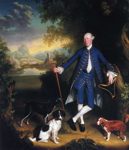
c. 1758-59. Oil on canvas. 1040 x 900 mm. Private collection.
- Jane Atkinson.
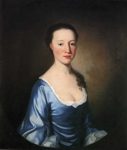
c. 1759. Oil on canvas. 760 x 660 mm. Abbot Hall Art Gallery, Kendal, UK.
- The Leigh Family.
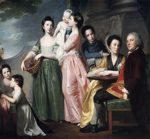
1768. Oil on canvas. 1860 x 2020 mm. National Gallery of Victoria, Melbourne, Australia.
- The Leigh Family. Detail.
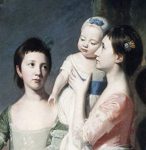
1768. Oil on canvas. 1860 x 2020 mm. National Gallery of Victoria, Melbourne, Australia.
- The Leigh Family. Detail.
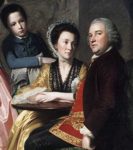
1768. Oil on canvas. 1860 x 2020 mm. National Gallery of Victoria, Melbourne, Australia.
- The Leigh Family. Detail.

1768. Oil on canvas. 1860 x 2020 mm. National Gallery of Victoria, Melbourne, Australia.